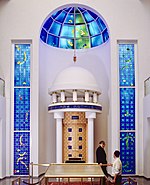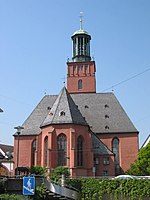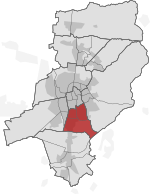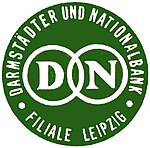People's State of Hesse

The People's State of Hesse (German: Volksstaat Hessen) was one of the constituent states of Germany from 1918 to 1945, as the successor to the Grand Duchy of Hesse (German: Großherzogtum Hessen) after the defeat of the German Empire in World War I, on the territory of the current German states of Hesse and the Rhineland-Palatinate. The State was established after Grand Duke Ernest Louis was deposed on 9 November 1918. The term "People's State" referred to the fact that the new state was a Republic (rather than implying that it was a socialist state) and was used in the same manner as the term Free State, which was employed by most of the other German States in this period. Like the Grand Duchy, the capital was Darmstadt and the state consisted of provinces Upper Hesse (German: Oberhessen, capital Gießen), Starkenburg (capital Darmstadt) and Rhenish Hesse (German: Rheinhessen, capital Mainz). The area of the state was 7,692 km²; it had 1,347,279 inhabitants in 1925. Around two-thirds professed Protestantism, the other third were Roman Catholics. Under the Law on the Reconstruction of the Reich of 30 January 1934, the Nazi government abolished the People's State's Landtag and transferred sovereignty from the People's State to the Reich, converting Hesse into an administrative unit of the central government, though formally it retained some local government. After the German surrender in May 1945, at the end of World War II, Upper Hesse and Starkenburg formed part of the American occupation zone, while Rhenish Hesse, on the left bank of the Rhine, fell within the French occupation zone. On September 19, 1945, American administrators merged the section of the People's State of Hesse with the Prussian provinces of Hesse and Nassau and Frankfurt am Main to form Greater Hesse (German: Groß-Hessen). Greater Hesse was renamed Hesse on December 1, 1946, and later became one of the federal states of West Germany. The parts of the state on the left bank of the Rhine became part of the new state of Rhineland-Palatinate (Rheinland-Pfalz) on 30 August 1946.
Excerpt from the Wikipedia article People's State of Hesse (License: CC BY-SA 3.0, Authors, Images).People's State of Hesse
Riedeselstraße, Darmstadt Darmstadt-Mitte (Darmstadt-Mitte)
Geographical coordinates (GPS) Address Nearby Places Show on map
Geographical coordinates (GPS)
| Latitude | Longitude |
|---|---|
| N 49.866666666667 ° | E 8.65 ° |
Address
Riedeselstraße 26
64283 Darmstadt, Darmstadt-Mitte (Darmstadt-Mitte)
Hesse, Germany
Open on Google Maps










